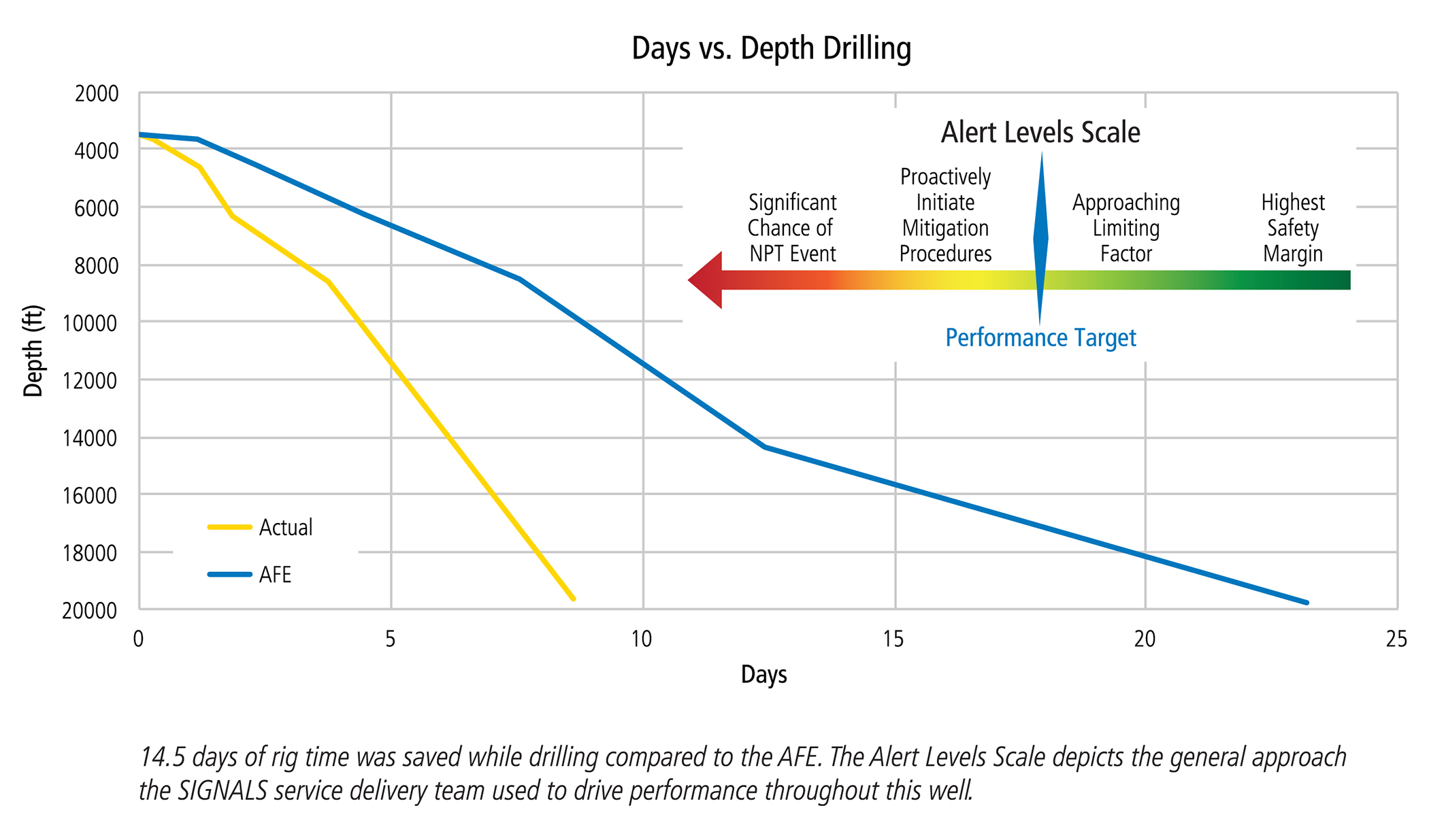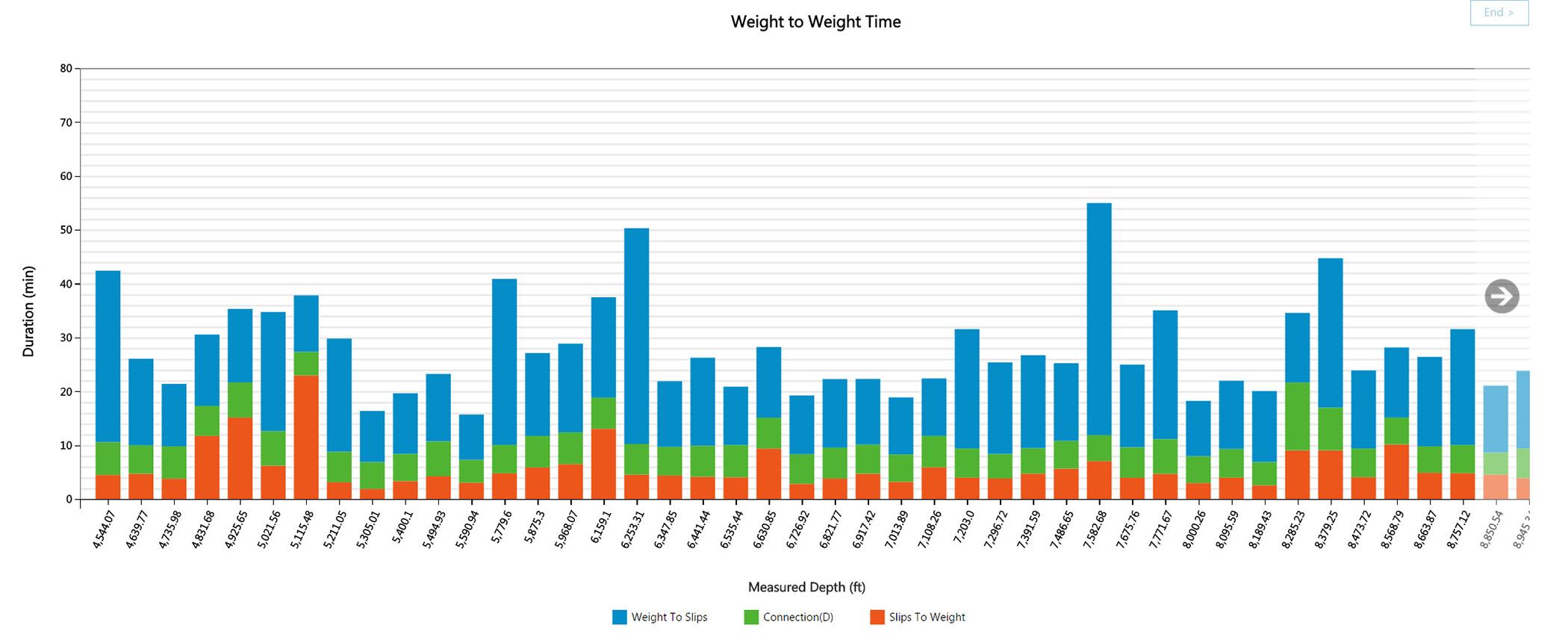During the process of drilling a well, operators must continually react to a complex interplay of geologic, hydraulic, mechanical and human factors if they are to successfully reach target depth. Despite continuing technological advances designed to drill longer and more complex wells, opportunities remain to improve drilling efficiency and safety in the face of tighter operating budgets.
Increased efficiency during the drilling process is directly related to the ability to mitigate nonproductive time (NPT), the time lost from events like wellbore issues and equipment failures, and invisible lost time (ILT) caused by inefficiencies in routine operations such as tripping pipe, back-reaming, or making up and breaking down equipment. NPT is the common target of most drillers’ efficiency measures, while ILT is difficult to identify, is rarely quantified and often accumulates during drilling activities. According to some industry sources, NPT can account for 10% to 40% of an operator’s budget, and ILT can add 20% to 40% in operating costs.
Improving surveillance, communication
Current shortcomings in improving drilling efficiency and safety prompted Baker Hughes to develop the SIGNALS remote drilling advisory service, designed to identify factors leading to ILT/NPT and proactively mitigate them in real time. The service, which leverages the company’s WellLink Drilling Suite software, combines skilled personnel, smart visualization, key performance indicator (KPI) monitoring applications and alarm manager software. This combination of people and tools identifies leading indicators of drilling-related problems in five categories that include KPI analysis, equivalent circulating density (ECD) management, hole cleaning, torque and drag, and drilling dynamics. Taken together, these categories provide a comprehensive analysis of hole condition and operational efficiency that affords a systematic means of characterizing drilling performance in terms of safety and efficiency.
In addition to the real-time analysis, the service’s extensive pre-section reviews minimize any surprises that might threaten the efficiency of the drilling process or the safety of the rig crew.
The drilling advisory service fosters a collaborative work relationship between the crew at the rig site and office-based personnel. Rig crews are highly task-focused and have numerous duties on the rig, while office personnel are frequently tied up in meetings and cannot consistently monitor field operations. To avoid any disconnects between rig practices and office expectations, a remote services engineer is tasked with directly communicating with drilling engineers and relaying information offshore.
The remote engineer also performs offset well analysis to benchmark target times, identify problem zones and offer suggestions to the well plan. The engineer and rig personnel collaboratively review the plan and devise mitigation strategies. During drilling operations the remote engineer maintains communications with rig and office personnel to ensure that plans are being followed, hazards are properly mitigated and new opportunities for efficiency improvements are pursued.
Finally, the service’s post-section reviews ensure that lessons learned are captured, good performance is highlighted and best practices are implemented in future sections of the well. Target times are refined after each section to reflect the capabilities of the rig and its crew. This post-analysis exercise saves time and costs on the very next section of the well to be drilled.
Saving rig time
Several deepwater operators have deployed the drilling advisory service to improve drilling performance under current adverse market conditions without compromising operational safety margins. One operator in the Gulf of Mexico implemented the service to increase operational efficiencies by targeting ECD margins, drilling parameters and back-reaming procedures.
Following a collaborative pre-well planning exercise with the operator, the Baker Hughes drilling crew went to work on the rig, with the remote services engineer maintaining constant communication between the rig and office personnel. The remote engineer’s analysis during the drilling phase directed multiple rig interventions aimed at staying ahead of problems that could increase rig times and costs.
The pre-well planning, including benchmarking target times, and real-time intervention enabled the integrated team to avoid hazardous events and safely drill the well significantly under budget. Each hole section was drilled under the planned time compared to the authorized funds for expenditure (AFE). Actual drilling time was less than nine days, a 60% reduction in drilling time compared to the 23 days of cumulative drilling time in the AFE.
In total, the well was drilled in just more than 36 days, a significant improvement over the 54 days allotted in the AFE plan. Nearly 80% of the time saved was attributed to operations while drilling. The comprehensive analysis achieved through collaboration between rig and office personnel established benchmark times and lessons learned for future wells.

(Source: Baker Hughes)
Identifying future time savings
Operators also have benefited from the advisory service’s historical well analysis to identify areas where future time and money might be saved during drilling. The service company deployed the service for a historical KPI analysis of 29 wells and 40 wellbores drilled by four rigs in four fields located offshore South America. The operator wanted to identify and mitigate areas of NPT and ILT to save money and provide tighter and more realistic budgets for future projects.
Data gathered by the advisory service was then integrated into the company’s WellLink RT service, a webbased service that optimizes the delivery of advanced visualization and analysis of real-time drilling data including LWD, mud logging, surface and environmental measurements. The data were analyzed to identify data density, hole size, casing concept evaluation, and rig type and capacities to ensure reasonable comparisons for accurate results. Corresponding sections of all wells also were incorporated in the analysis to build a visual concept of a composite ideal well that highlighted areas for real-world performance improvement.

An example of the Weight to Weight KPI visual from WellLink Performance depicts the time from kelly down after drilling a stand to back on bottom drilling after the connection. This visual is used to easily identify best practices as well as outliers in comparison to performance target times. (Source: Baker Hughes)
Drilling operations KPIs were evaluated for connection procedures, circulating times, reaming at connections, ROP and tripping speeds. These KPIs were evaluated by field, rig, well, section and rig crew using the company’s WellLink Performance service, which analyzes historic and real-time wellsite data to identify a comprehensive drilling performance solution. The analysis uncovered areas of ILT due to inefficient practices, which the crew corrected for future wells.
Overall, the drilling advisory service helped the operator build a composite best well and implement NPT and ILT solutions, resulting in a time savings of about 6.5 days or 24% on the fastest well drilled in all four fields.
These are two examples of how the SIGNALS remote drilling advisory service successfully marries continuous surveillance and proactive communication to bridge the gap between the rig and the office. By identifying and mitigating NPT/ILT in real time, the service highlights opportunities for improved drilling efficiency and safety in future wells on tighter budgets, allowing operators to remain competitive in a struggling market.
Recommended Reading
Williams Completes Mid-Atlantic Transco Expansion Project
2024-12-30 - Williams Cos.'s Transco Southside Reliability Enhancement project is now online.
FERC Reinstates Permit for Williams’ Mid-Atlantic Project
2025-01-27 - The Federal Energy Regulatory Commission’s latest move allows Williams’ Transco natural gas network to continue operations after a D.C. court shot down the expansion plan.
DC Circuit Denies Rehearing for Williams’ Mid-Atlantic Project
2025-01-23 - Williams Cos.’ Regional Energy Access will continue operating as the midstream company seeks an emergency FERC certificate to keep supplying natural gas to Pennsylvania, New Jersey and Maryland.
Gas & Midstream Weekly: Cushing Crude Storage Levels Near All-Time Lows
2025-01-16 - Low levels of crude in storage could cause problems across the U.S. supply chain; a "gas super-cycle" may be coming; and Liberty Energy's Chris Wright testifies to the Senate.
Boardwalk Project Steps Up in Competitive Southeast Market
2024-12-12 - Boardwalk Pipelines' Kosciusko Junction project has reached FID as power generation and data centers’ energy demand pull natural gas to the eastern Gulf Coast.
Comments
Add new comment
This conversation is moderated according to Hart Energy community rules. Please read the rules before joining the discussion. If you’re experiencing any technical problems, please contact our customer care team.




